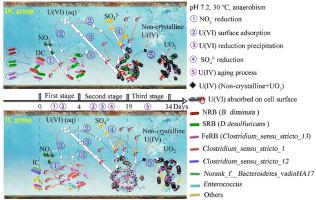铀的微生物还原(VI)由设计和本土财团:效率和动态行为
IF 7.7
2区 环境科学与生态学
Q1 ENVIRONMENTAL SCIENCES
引用次数: 0
摘要
本研究旨在探讨在微生物铀还原过程中,具有特定功能的特定微生物是否与本土财团(IC)相当甚至优于本土财团(IC),并检测不同微生物财团对U(VI)的固定化机制。采用铁(III)还原菌(FeRB)、硫酸盐还原菌(SRB)和硝酸盐还原菌(NRB)构建设计联合体(DC),并从天然样品中获得IC。结果表明,34 d后,DC的铀还原率(52.69%)高于IC(35.65%),但IC的铀去除率(98.75%)略高于DC(95.75%)。在DC组和IC组中,铀在前几天首先被吸附到细胞表面,然后硝酸盐耗尽后硫酸盐和铀同时被还原,最后随着时间的推移,不稳定的U种转化为稳定的形式(如UO2)。这项工作完善了我们对高效铀还原微生物构建的理解,并为加强原位处理铀污染地下水的策略提供了见解。本文章由计算机程序翻译,如有差异,请以英文原文为准。

Microbial reduction of uranium (VI) by designed and indigenous consortium: efficiencies and dynamic behavior
This study was conducted to investigate whether selected microbes with specific functions are comparable or even superior to indigenous consortium (IC) in the microbial uranium reduction process and to detect the immobilization mechanisms of U(VI) with different microbial consortia. Fe(III)-reducing bacteria (FeRB), sulfate-reducing bacteria (SRB) and nitrate-reducing bacteria (NRB) were employed to construct a designed consortium (DC), and the IC was obtained from natural samples. The results showed that the uranium-reducing ratio of the DC was higher (52.69 %) than that of the IC (35.65 %) after 34 days, although the uranium removal ratio with IC (98.75 %) was slightly higher than that of the DC (95.75 %). In both the DC and IC groups, uranium was first adsorbed onto the cell surface in the first few days, then sulfate and uranium were reduced simultaneously after depletion of nitrate, and finally labile U species transformed into stable form (e.g UO2) over time. This work refined our understanding of the construction of highly efficient uranium-reducing microbes and provided insight into strengthening strategies for treating uranium-contaminated groundwater in situ.
求助全文
通过发布文献求助,成功后即可免费获取论文全文。
去求助
来源期刊

Environmental Research
环境科学-公共卫生、环境卫生与职业卫生
CiteScore
12.60
自引率
8.40%
发文量
2480
审稿时长
4.7 months
期刊介绍:
The Environmental Research journal presents a broad range of interdisciplinary research, focused on addressing worldwide environmental concerns and featuring innovative findings. Our publication strives to explore relevant anthropogenic issues across various environmental sectors, showcasing practical applications in real-life settings.
 求助内容:
求助内容: 应助结果提醒方式:
应助结果提醒方式:


